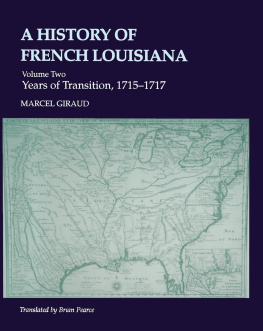Published with the assistance of the John and Virginia Noland Fund
Published by Louisiana State University Press
www.lsupress.org
Copyright 2021 by Louisiana State University Press
All rights reserved. Except in the case of brief quotations used in articles or reviews, no part of this publication may be reproduced or transmitted in any format or by any means without written permission of Louisiana State University Press.
Designer: Barbara Neely Bourgoyne
Typeface: Whitman
Original illustrations are copyright Jonathan Mayers and cannot be reproduced without the express permission of the artist. Mayers may be contacted at jonathanmayers.com.
Cover illustration: Jonathan Mayers, Lapin, un puits, puis un feufollet . Acrylic on panel. 2020.
Portions of chapter 2 first appeared in Roquelaure: A New Perspective on Louisiana Folklores Master Thief, Louisiana Folklore Miscellany 27 (2017): 2952, and are reproduced by permission of the editor. Portions of chapter 3 first appeared in Les Reprsentations de Jean le Sot dans le contexte francophone, Port Acadie 31 (2017): 722, and are reproduced by permission of the editor.
Library of Congress Cataloging-in-Publication Data
Names: Rabalais, Nathan J., author.
Title: Folklore figures of French and Creole Louisiana / Nathan J. Rabalais.
Description: Baton Rouge : Louisiana State University Press, 2021. | Includes bibliographical references and index.
Identifiers: LCCN 2020042414 (print) | LCCN 2020042415 (ebook) | ISBN 978-0-8071-7481-4 (cloth) | ISBN 978-0-8071-7556-9 (pdf) | ISBN 978-0-8071-7557-6 (epub)
Subjects: LCSH: FolkloreLouisiana. | TalesLouisiana. | CajunsFolklore. | CreolesLouisianaFolklore. | LouisianaSocial life and customs.
Classification: LCC GR110.L5 R34 2021 (print) | LCC GR110.L5 (ebook) | DDC 398.209763dc23
LC record available at https://lccn.loc.gov/2020042414
LC ebook record available at https://lccn.loc.gov/2020042415
Acknowledgments
In many ways, this book is the result of several years of research and many people who contributed their time and expertise to this project. In the early stages of my work on oral tradition, countless friends and colleagues offered their time and advice as I worked through many questions and challenges. Andr Magord at Universit de Poitiers and Elizabeth Poe at Tulane University were particularly instrumental. The Fulbright-Chateaubriand fellowship and the Commission franco-amricaine made possible the extended access to archival sources in France. Barry Ancelet, Marlne Belly, Frank DeCaro, Thomas Klingler, and Dana Kress all offered their expertise in the formative stages of my research on folklore. I am grateful to the MIMMOC (Mmoires, identits, marginalits dans le monde occidental contemporain) research laboratory at the Universit de Poitiers for its welcome, support, and office space. This project would not have been possible without the support of a twelve-month fellowship from the National Endowment of the Humanities and a research leave granted by William & Mary. I thank the Reves Center for International Studies for its support of several research and conference trips that indirectly benefited my work on folklore. Deans for Educational Policy LuAnn Homza and Jonathan Donahue as well as the Dean of Arts & Sciences at William & Mary generously supported my travel to consult archival sources in Louisiana, France, and Canada. Administrative coordinators Rebecca Bliley, Michelle Sherman, and Melissa Johnson contributed greatly to the successful sponsorship of my research trips. Aleksandra Grzybowska, Flavie-Isabelle Hade, and everyone at the Centre de la Francophonie des Amriques has also greatly supported my work over the years.
The many librarians and archivists deserve much credit for their tireless work and precious knowledge of sound and documentary records. In particular, John Pudd Sharp, Chris Segura, and Joshua Caffery at the Center for Louisiana Studies (CLS); Stphanie Coulais and Sandra Egreteau at the Centre dtudes de recherche et de documentation sur loralit (CERDO) at the UPCP-Mtive in Parthenay; Sean Benjamin and Leon Miller at Tulane Universitys Louisiana Research Collection (LARC); Rodolphe Defiolle at the Centre de documentation of the Universit de Poitiers; Robert Richard and Frank LeBlanc at the Centre dtudes acadiennes Anselme Chiasson at the Universit de Moncton; and Valrie Asselin at the Archives de folklore et dethnologie of the Universit Laval. To the many people in Poitiers who made me and my wife feel at home: Jean-Luc Terradillos and Dominique Truco; Stphanie, Grard, and Franoise Moreau; and Elodie Gallet, Kelly Fazilleau, Simon Fleury, and Agathe Marie. A special thanks to Du and Philippe Aldon for their friendship and support. This book is also dedicated to the memory of those important cultural figures whom we have lost since this project began: Frank DeCaro, Liliane Jagueneau, and Michel Valire.
One of the aspects of my work that I truly enjoy the most is conversing with dear colleagues and friends with whom I enjoy exchanging ideas regularly. Clint Bruce, Joseph Dunn, Dana Kress, Christophe Landry, and Robin Whiteyour intellectual curiosity and generous spirit are so appreciated. I also thank Rachel Doherty and Ryan Langley for their time and insight. It has been a privilege to have many mentors who have helped, encouraged, and inspired me over the years, including Barry Ancelet, Amanda LaFleur, Kirby Jambon, Andr Magord, Brenda Mounier, and Ebba and Tom Schoonover.
I would like to thank the professors, colleagues, and university administrators at multiple institutions who have supported my academic career over the years and facilitated the writing of this book in particular. My scholarship in francophone studies would not have been possible without the initial training that I received from my professors at the University of Louisiana at Lafayette, including several whom I am honored to call colleagues today: Barry Ancelet, Deborah Clifton, Fabrice Leroy, Amadou Oudraogo, and Monica Wright, who were instrumental in encouraging me to pursue my interests in academia. I also extend my gratitude to my former colleagues in the French and Francophone Studies program at William & Mary for their encouragement and friendship: Brett Brehm, Vanessa Brutsche, Magali Compan, Kate Conley, Katherine Kulick, Dborah Lee-Ferrand, Angela Leruth, Michael Leruth, Giulia Pacini, and Julie Hugonny. I thank the university and departmental leadership at William & Mary for the support that was kindly extended to me as a faculty member. Maryse Fauvel and Silvia Tandeciarz, as chairs, were both extremely supportive of my research endeavors. Many other colleagues in the Department of Modern Languages and Literatures have been valuable interlocutors and sources of encouragement: Carla Buck, Veronika Burney, Paulina Carrion, Francie Cate-Arries, Driss Cherkaoui, Michael Cronin, Sergio Ferrarese, Jennifer Glly, Michael Hill, Robert Leventhal, Teresa Longo, Sara Mattavelli, Mariana Melo-Vega, Alexander Prokhorov, Elena Prokhorova, John Riofrio, Tomoyuki Sasaki, Monica Seger, Stephen Sheehi, Ann Marie Stock, Jennifer Taylor, Jorge Terukina, and Mona Zaki. Thank you to the departments student workers Gabriella and Marianna for your time and help with scanning loaned materials. I am so grateful for the support and friendship of Cindy DuPuy and Eric Christenson in Williamsburg. Finally, I would like to express my gratitude to my colleagues at the University of Louisiana at Lafayette, especially Regina LaBiche, Administrative Assistant, Monica Wright, Department Head, and all of the Department of Modern Languages, the Center for Louisiana Studies, as well as Dean Jordan Kellman and the College of Liberal Arts, for welcoming me into this dynamic program and for promoting the advancement of Louisiana studies.






